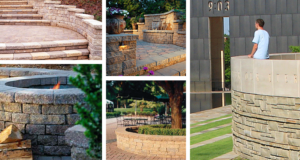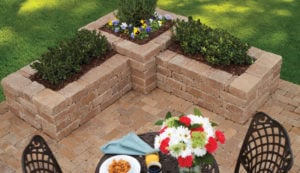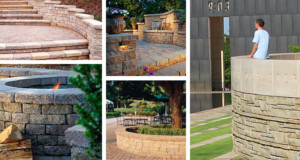Are you planning a stunning rock landscape and wondering, how many cubic feet of rock are in a ton? At rockscapes.net, we understand that calculating the correct amount of rock for your project is essential for success. This guide provides a comprehensive breakdown of converting tons to cubic feet, ensuring you order the perfect amount of decorative rock, landscape stone, or gravel for your needs. This knowledge will empower you to estimate material costs, plan efficiently, and ultimately achieve your desired rock coverage.
1. Understanding the Basics: Weight, Volume, and Density
Before diving into calculations, let’s clarify the core concepts:
- Weight: Measured in tons (2000 pounds).
- Volume: Measured in cubic feet.
- Density: The mass per unit volume of a substance (pounds per cubic foot, or lbs/ft³). Density is the crucial link between weight and volume.
Essentially, knowing the density of the rock you’re using will allow you to accurately convert between tons and cubic feet. Different types of rocks have different densities. According to research from Arizona State University’s School of Earth and Space Exploration, rock density significantly impacts construction and landscaping material calculations.
2. Why Does Rock Density Matter for Landscaping?
Rock density isn’t just a scientific term; it has practical implications for your landscaping project:
- Accurate Material Estimation: Density ensures you order the right amount of rock, preventing costly overages or frustrating shortages.
- Structural Integrity: In projects like retaining walls, understanding density helps ensure the wall’s stability and longevity.
- Transportation Planning: Knowing the weight of your rock order is vital for arranging appropriate transportation and handling equipment.
- Cost Management: Accurate estimations prevent budget overruns due to miscalculated material needs.
3. Factors Affecting Rock Density
Several factors influence the density of rocks:
- Mineral Composition: Different minerals have different densities. Rocks composed of heavier minerals (like iron) will be denser.
- Porosity: The amount of empty space (pores) within a rock. Higher porosity means lower density.
- Compaction: How tightly the mineral grains are packed together. Greater compaction increases density.
- Moisture Content: Water adds weight. Rocks saturated with water will weigh more per cubic foot than dry rocks.
4. Common Rock Densities for Landscaping
To give you a general idea, here are the approximate densities of some commonly used landscaping rocks:
| Rock Type | Approximate Density (lbs/ft³) |
|---|---|
| River Rock | 150-170 |
| Lava Rock | 50-80 |
| Crushed Stone | 90-120 |
| Granite | 160-180 |
| Limestone | 150-170 |
| Flagstone | 160-180 |
| Pea Gravel | 100-120 |
| Decomposed Granite | 90-110 |
| Slate | 160-175 |
Important Note: These are estimates. Always check with your supplier at rockscapes.net for the specific density of the rock you’re purchasing. Variations can occur even within the same rock type.
5. The Formula: Converting Tons to Cubic Feet
Here’s the formula to calculate how many cubic feet are in a ton of rock:
*Cubic Feet = (2000 lbs / Density in lbs/ft³) Number of Tons**
Let’s break it down:
- 2000 lbs: The number of pounds in one ton.
- Density in lbs/ft³: The density of your specific rock type (refer to the table above or your supplier).
- Number of Tons: The number of tons of rock you plan to purchase.
Example:
You’re buying 3 tons of river rock, which has a density of 160 lbs/ft³.
Cubic Feet = (2000 lbs / 160 lbs/ft³) * 3 tons
Cubic Feet = 12.5 ft³/ton * 3 tons
Cubic Feet = 37.5 ft³
Therefore, 3 tons of river rock will occupy approximately 37.5 cubic feet.
6. Step-by-Step Calculation Guide
Follow these steps for accurate calculations:
- Identify Your Rock Type: Determine the exact type of rock you’ll be using (e.g., Arizona river rock, Pennsylvania flagstone).
- Find the Density: Obtain the density of your specific rock type from your supplier at rockscapes.net. Don’t rely solely on general estimates.
- Determine Tonnage: Calculate the number of tons required for your project, based on area and desired depth (more on this later).
- Apply the Formula: Use the formula above to convert tons to cubic feet.
- Account for Waste: Add a percentage (5-10%) to your calculation to account for waste, settling, and uneven distribution.
7. Practical Applications: Calculating Rock Needs for Common Landscaping Projects
Let’s apply this knowledge to some real-world scenarios:
7.1. Rock Mulch for Garden Beds
Scenario: You want to cover a garden bed that is 10 feet long and 5 feet wide with 2 inches of lava rock.
- Area: Length x Width = 10 ft x 5 ft = 50 sq ft
- Depth in Feet: 2 inches / 12 inches/foot = 0.167 ft
- Volume in Cubic Feet: Area x Depth = 50 sq ft x 0.167 ft = 8.35 ft³
- Density of Lava Rock: Approximately 65 lbs/ft³ (check with your rockscapes.net supplier)
- Weight in Pounds: Volume x Density = 8.35 ft³ x 65 lbs/ft³ = 542.75 lbs
- Weight in Tons: 542.75 lbs / 2000 lbs/ton = 0.27 tons
- Account for Waste (5%): 0.27 tons x 0.05 = 0.0135 tons
- Total Tons Required: 0.27 tons + 0.0135 tons = 0.2835 tons
You’ll need approximately 0.2835 tons of lava rock for your garden bed.
 Lava rock mulch used in a garden bed to suppress weeds and retain moisture.
Lava rock mulch used in a garden bed to suppress weeds and retain moisture.
7.2. Gravel Driveway
Scenario: You’re building a gravel driveway that is 50 feet long and 10 feet wide, with a depth of 4 inches of crushed stone.
- Area: Length x Width = 50 ft x 10 ft = 500 sq ft
- Depth in Feet: 4 inches / 12 inches/foot = 0.333 ft
- Volume in Cubic Feet: Area x Depth = 500 sq ft x 0.333 ft = 166.5 ft³
- Density of Crushed Stone: Approximately 105 lbs/ft³ (check with your rockscapes.net supplier)
- Weight in Pounds: Volume x Density = 166.5 ft³ x 105 lbs/ft³ = 17482.5 lbs
- Weight in Tons: 17482.5 lbs / 2000 lbs/ton = 8.74 tons
- Account for Waste (10%): 8.74 tons x 0.10 = 0.874 tons
- Total Tons Required: 8.74 tons + 0.874 tons = 9.614 tons
You’ll need approximately 9.614 tons of crushed stone for your driveway.
7.3. River Rock Border
Scenario: You want to create a river rock border around a circular patio with a diameter of 20 feet, using a border width of 1 foot and a depth of 3 inches.
- Calculate the Circumference: Circumference = π (pi) diameter = 3.14159 20 ft = 62.83 ft (approx.)
- Calculate the Area of the Border: Think of the border as a rectangular shape wrapped around the circle.
- Area = Length (Circumference) Width = 62.83 ft 1 ft = 62.83 sq ft
- Depth in Feet: 3 inches / 12 inches/foot = 0.25 ft
- Volume in Cubic Feet: Area Depth = 62.83 sq ft 0.25 ft = 15.71 ft³
- Density of River Rock: Approximately 160 lbs/ft³ (check with your rockscapes.net supplier)
- Weight in Pounds: Volume Density = 15.71 ft³ 160 lbs/ft³ = 2513.6 lbs
- Weight in Tons: 2513.6 lbs / 2000 lbs/ton = 1.26 tons
- Account for Waste (5%): 1.26 tons * 0.05 = 0.063 tons
- Total Tons Required: 1.26 tons + 0.063 tons = 1.323 tons
You’ll need approximately 1.323 tons of river rock for your border.
 A river rock border adds a natural touch and defines the edge of a garden bed.
A river rock border adds a natural touch and defines the edge of a garden bed.
8. Online Calculators and Resources
While these formulas are effective, several online calculators can simplify the process. However, always double-check the results and ensure you’re using accurate density values for your chosen rock. Rockscapes.net may also offer calculation tools or guides specific to our products.
9. Tips for Accurate Measurement and Ordering
- Measure Carefully: Accurate measurements are crucial. Double-check your length, width, and depth.
- Consider the Base: If you’re filling an area, consider the existing base material. You may need less rock if you already have a solid foundation.
- Consult Experts: Don’t hesitate to contact rockscapes.net for expert advice. We can help you choose the right rock and estimate quantities.
- Order in Advance: Order your rock well in advance of your project to ensure availability and allow for delivery time.
- Delivery Access: Ensure you have adequate access for delivery trucks to drop off your rock order.
- Storage: Plan where you’ll store the rock before you start your project.
10. The Importance of Quality Rock from Rockscapes.net
Beyond accurate calculations, the quality of your rock is paramount. At rockscapes.net, we provide:
- Premium Selection: A wide variety of decorative rock, landscape stone, and gravel to suit any style and budget.
- Consistent Quality: We ensure our rocks are consistently sized, shaped, and free from debris.
- Accurate Information: We provide accurate density information for all our products, empowering you to make informed decisions.
- Expert Advice: Our team is ready to assist you with project planning, rock selection, and quantity estimation.
- Reliable Delivery: We offer dependable delivery services to get your rock to your project site on time.
- Competitive Pricing: We offer competitive pricing without compromising on quality.
11. Common Mistakes to Avoid
- Using Incorrect Density Values: This is the most common mistake. Always verify the density with your supplier.
- Neglecting Waste: Failing to account for waste can lead to shortages.
- Ignoring Settling: Rock will settle over time, especially gravel. Plan for this by adding extra material.
- Assuming Uniform Depth: Uneven surfaces require more rock to achieve the desired depth.
- Overlooking Drainage: Proper drainage is essential for the longevity of your rock landscape.
12. Advanced Considerations: Compaction and Angularity
For more complex projects, consider these factors:
- Compaction: Some rocks, like gravel, compact over time. This reduces the volume they occupy.
- Angularity: Angular rocks (like crushed stone) tend to interlock, creating a more stable base. Rounded rocks (like river rock) may shift more easily.
- Geotextiles: Using geotextiles (landscape fabric) beneath your rock can prevent weed growth and help stabilize the base.
13. Environmental Considerations
- Sourcing: Choose rocks from sustainable sources.
- Permeability: Consider the permeability of your chosen rock. Permeable rocks allow water to drain through, reducing runoff.
- Heat Absorption: Dark-colored rocks absorb more heat than light-colored rocks. Consider this when planning pathways or patios.
14. Visualizing Your Project: Design Ideas and Inspiration
Explore the endless possibilities of rock landscaping with these ideas:
- Rock Gardens: Create a stunning rock garden with a variety of rock sizes, shapes, and textures.
- Dry Creek Beds: Construct a dry creek bed to add visual interest and manage water runoff.
- Retaining Walls: Build a retaining wall to create level areas and prevent soil erosion.
- Pathways: Design inviting pathways with gravel, flagstone, or stepping stones.
- Water Features: Incorporate rocks into water features like ponds, waterfalls, and fountains.
- Fire Pits: Create a cozy fire pit area with a circular rock border.
- Zen Gardens: Design a tranquil Zen garden with carefully placed rocks and gravel.
15. Finding the Perfect Rock: A Guide to Selection
Choosing the right type of rock is crucial for the success of your project. Here’s a quick guide to some popular options:
| Rock Type | Characteristics | Common Uses |
|---|---|---|
| River Rock | Smooth, rounded stones in various sizes and colors. | Borders, dry creek beds, water features, ground cover. |
| Lava Rock | Lightweight, porous rock with a reddish-brown or black color. | Mulch, rock gardens, fire pits, drainage. |
| Crushed Stone | Angular, fragmented rock in various sizes. | Driveways, pathways, base material, drainage. |
| Granite | Hard, durable rock with a speckled appearance. | Retaining walls, pathways, borders, accent stones. |
| Limestone | Sedimentary rock with a light gray or beige color. | Retaining walls, pathways, borders, ground cover. |
| Flagstone | Flat, slab-like stones in various colors and textures. | Patios, walkways, stepping stones, retaining walls. |
| Pea Gravel | Small, rounded gravel in various colors. | Pathways, ground cover, drainage, playgrounds. |
| Decomposed Granite | Granular material that compacts well. | Pathways, driveways, base material. |
| Slate | Fine-grained, metamorphic rock that splits into thin layers. | Patios, walkways, roofing, decorative accents. |
| Boulders | Large, natural rocks that add drama and visual interest. | Focal points, retaining walls, rock gardens. |
Remember to consider the color, texture, size, and shape of the rock when making your selection. Also, think about how the rock will complement your existing landscape and home.
16. Addressing Common Concerns
- Cost: Rock can be a significant investment. Compare prices from different suppliers and consider using a combination of rock types to save money.
- Maintenance: Rock landscapes require some maintenance, such as weeding and removing debris.
- Installation: Installing rock can be labor-intensive. Consider hiring a professional landscaper for larger projects.
- Safety: Be careful when handling heavy rocks. Wear gloves and appropriate footwear.
17. Case Studies: Successful Rock Landscaping Projects
- The Desert Oasis: A homeowner in Arizona transformed their barren backyard into a stunning desert oasis with native rocks, cacti, and succulents.
- The Mountain Retreat: A family in Colorado created a natural-looking rock garden with boulders, river rock, and alpine plants.
- The Coastal Escape: A couple in California designed a serene coastal garden with smooth beach pebbles, driftwood, and drought-tolerant plants.
These case studies demonstrate the versatility and beauty of rock landscaping.
18. The Future of Rock Landscaping
Rock landscaping is evolving with new trends and technologies:
- Sustainable Sourcing: Increased emphasis on using locally sourced and recycled rocks.
- Xeriscaping: Designing landscapes that require minimal water.
- Permeable Pavements: Using permeable pavers and gravel to reduce runoff and recharge groundwater.
- 3D Modeling: Using 3D modeling software to visualize rock landscapes before installation.
19. Frequently Asked Questions (FAQs)
1. How many cubic feet are in a ton of gravel?
The cubic feet in a ton of gravel varies depending on the type of gravel and its density. Typically, gravel density ranges from 100 to 120 lbs/ft³. Thus, a ton of gravel will occupy approximately 16.7 to 20 cubic feet. Always confirm the specific density with your supplier at rockscapes.net for accurate calculations.
2. How much does a cubic foot of rock weigh?
The weight of a cubic foot of rock depends on its density. For example, a cubic foot of river rock (density 160 lbs/ft³) weighs about 160 pounds, while a cubic foot of lava rock (density 65 lbs/ft³) weighs about 65 pounds.
3. How do I calculate how much rock I need for my project?
First, determine the area you want to cover (length x width). Then, decide on the desired depth of the rock in feet. Multiply the area by the depth to get the volume in cubic feet. Finally, convert cubic feet to tons using the density of your chosen rock. Don’t forget to add extra for waste and settling.
4. What is the best type of rock for drainage?
Crushed stone and pea gravel are excellent choices for drainage due to their angular shapes and ability to create voids for water to flow through.
5. How do I prevent weeds from growing in my rock landscape?
Use a geotextile (landscape fabric) beneath the rock to prevent weed growth. You can also apply a pre-emergent herbicide.
6. How do I clean my rock landscape?
Rinse the rocks with a garden hose to remove dirt and debris. You can also use a pressure washer on a low setting.
7. Where can I buy quality landscaping rocks?
Rockscapes.net offers a wide selection of premium landscaping rocks, with accurate density information and expert advice.
8. What is the difference between gravel and crushed stone?
Gravel consists of naturally weathered rock fragments, while crushed stone is produced by mechanically crushing larger rocks. Crushed stone tends to be more angular, while gravel is more rounded.
9. How do I estimate the cost of my rock landscaping project?
Determine the amount of rock you need in tons. Then, multiply the tonnage by the price per ton. Don’t forget to factor in delivery costs and installation fees.
10. Can I mix different types of rocks in my landscape?
Yes, mixing different types of rocks can add visual interest and texture to your landscape. Just be sure to choose rocks that complement each other in color and style.
20. Call to Action
Ready to transform your outdoor space with the beauty and durability of rock? Visit rockscapes.net today to explore our extensive selection of decorative rock, landscape stone, and gravel. Discover inspiring design ideas, get detailed product information, and receive expert advice from our knowledgeable team. Let rockscapes.net help you create the landscape of your dreams! Contact us at Address: 1151 S Forest Ave, Tempe, AZ 85281, United States. Phone: +1 (480) 965-9011. We are here to help!
By understanding the relationship between weight, volume, and density, you can confidently calculate your rock needs and bring your landscaping vision to life. Whether you’re creating a serene rock garden, a durable driveway, or a stunning water feature, rockscapes.net is your trusted partner for quality rock and expert guidance.
